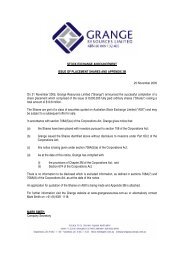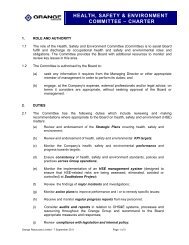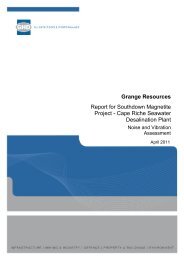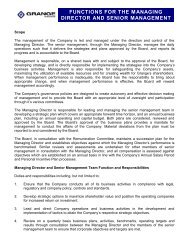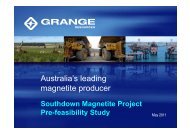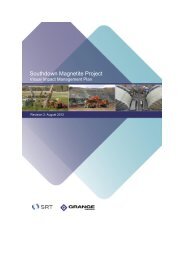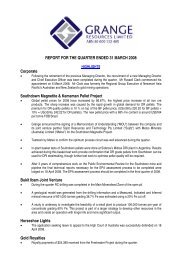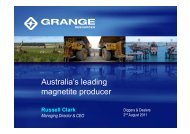Albany Iron Ore Project Visual Impact Assessment - Grange ...
Albany Iron Ore Project Visual Impact Assessment - Grange ...
Albany Iron Ore Project Visual Impact Assessment - Grange ...
- No tags were found...
You also want an ePaper? Increase the reach of your titles
YUMPU automatically turns print PDFs into web optimized ePapers that Google loves.
<strong>Albany</strong> <strong>Iron</strong> <strong>Ore</strong> <strong>Project</strong><strong>Visual</strong> <strong>Impact</strong> <strong>Assessment</strong>
This page has been left intentionally blank.<strong>Albany</strong> <strong>Iron</strong> <strong>Ore</strong> <strong>Project</strong><strong>Visual</strong> <strong>Impact</strong> <strong>Assessment</strong>
<strong>Albany</strong> <strong>Iron</strong> <strong>Ore</strong> <strong>Project</strong><strong>Visual</strong> <strong>Impact</strong> <strong>Assessment</strong>RevNo.Rev 1Rev 2Author Reviewer/sDocument StatusDateApproved for IssueName DistributedToR. MattinsonV. EeB. WilliamsonN. MarstonRev 3J. ClearyR. MattinsonPeer ReviewerRev 4 R. Mattinson V. Ee 280906B. WilliamsonN. MarstonEPASUDoECALMDoIRPACUDate09/01/06ecologia Environment (2006). Reproduction of this report in whole or in part byelectronic, mechanical or chemical means including photocopying, recording or by anyinformation storage and retrieval system, in any language, is strictly prohibited without theexpress approval of <strong>Grange</strong> Resources Limited, <strong>Albany</strong> Port Authority and/or ecologiaEnvironment.Restrictions on UseThis report has been prepared specifically for <strong>Grange</strong> Resources Limited and <strong>Albany</strong> PortAuthority. Neither the report nor its contents may be referred to or quoted in any statement,study, report, application, prospectus, loan, or other agreement document, without theexpress approval of <strong>Grange</strong> Resources Limited, <strong>Albany</strong> Port Authority and/or ecologiaEnvironment.ecologia Environment1025 Wellington StWEST PERTH WA 6005Phone: 08 9322 1944Fax: 08 9322 1599Email: valarie.ee@ecologia.com.au1
<strong>Albany</strong> <strong>Iron</strong> <strong>Ore</strong> <strong>Project</strong><strong>Visual</strong> <strong>Impact</strong> <strong>Assessment</strong>This page has been left intentionally blank.2
<strong>Albany</strong> <strong>Iron</strong> <strong>Ore</strong> <strong>Project</strong><strong>Visual</strong> <strong>Impact</strong> <strong>Assessment</strong>Table of Contents1......<strong>Project</strong> Overview and <strong>Assessment</strong> Scope ..............................................................................92......<strong>Assessment</strong> of Landscape Values .........................................................................................173......Planning and Legal Context....................................................................................................183.1...........Environmental Protection Authority...................................................................................183.2...........Department of Environment and Conservation .................................................................183.3...........Department of Environment and Heritage.........................................................................193.4...........Western Australian Planning Commission ........................................................................193.5...........The City of <strong>Albany</strong> .............................................................................................................214......<strong>Visual</strong> <strong>Impact</strong> <strong>Assessment</strong> Method........................................................................................224.1...........Objective............................................................................................................................224.2...........Peer Review and Consultation ..........................................................................................224.3...........Non-view Based <strong>Assessment</strong>............................................................................................224.3.1 ................Landscape Significance............................................................................................224.3.2 ................Wilderness Quality....................................................................................................234.3.3 ................Community Use and Access.....................................................................................234.4...........View Based <strong>Assessment</strong>...................................................................................................274.4.1 ................Landscape Character ...............................................................................................274.4.2 ................View Location Selection............................................................................................274.4.3 ................View Location <strong>Assessment</strong>.......................................................................................284.5...........<strong>Assessment</strong> of <strong>Impact</strong>s and Mitigation Measures.............................................................295......<strong>Assessment</strong> Results ................................................................................................................415.1...........Non-View Based <strong>Assessment</strong> ...........................................................................................415.1.1 ................Landscape Significance............................................................................................415.1.2 ................Wilderness Quality....................................................................................................425.1.3 ................Community Use, Access and Sensitivity ..................................................................435.2...........View Based <strong>Assessment</strong>...................................................................................................475.2.1 ................Landscape Character ...............................................................................................475.2.2 ................Roads Surrounding the Mine Site (View Locations 1,4,6,7 and 8)...........................475.2.3 ................Aerial Views ..............................................................................................................475.2.4 ................Gnowellen Road (View Locations 2 and 3) ..............................................................535.2.5 ................South Coast Highway (View Location 5) ..................................................................555.2.6 ................Bluff Knoll (View Locations 29 and 30).....................................................................595.2.7 ................Marine Drive and Mount Adelaide (View Locations 13a, 13b, 13f 14) .....................615.2.8 ................<strong>Albany</strong> Maritime Heritage Trail Lookout (View Location 21) ....................................615.2.9 ................Marine Drive and the Boardwalk (Locations 13 and 22 -25) ....................................615.2.10 ..............Desert Mounted Corps Memorial and Mount Clarence Lookout (View Location 15 -16).............................................................................................................................685.2.11 ..............Ataturk’s Memorial and Pagoda and Point King (View Locations 26-28).................705.2.12 ..............Frenchman Bay Road, Bay View Drive and Stuarts Head Lookout (View Locations9-11)..........................................................................................................................755.2.13 ..............Possession Point Walk Trail (View Locations 17-19) ...............................................795.2.14 ..............Possession Point (View Location 20) .......................................................................825.2.15 ..............Entrance to the Princess Royal Harbour (View Location 31) ...................................875.3...........Summary of <strong>Impact</strong> <strong>Assessment</strong> and Mitigation Measures ..............................................935.3.1 ................Mine Site ...................................................................................................................935.3.2 ................Port Infrastructure .....................................................................................................946......References................................................................................................................................97Appendix 1 – Peer Review ...............................................................................................................993
<strong>Albany</strong> <strong>Iron</strong> <strong>Ore</strong> <strong>Project</strong><strong>Visual</strong> <strong>Impact</strong> <strong>Assessment</strong>List of FiguresFigure 1.1 General Location Plan. ............................................................................................ 11Figure 1.2 Conceptual Mine Footprint....................................................................................... 13Figure 1.3 Proposed Dredge Channel and Offshore Disposal Site. ......................................... 15Figure 4.1 View Locations Assessed for the Mine Site............................................................. 31Figure 4.2 Schematic Diagram of Southdown <strong>Ore</strong> Processing Facilities Elevations. .............. 33Figure 4.3 View Locations Assessed for the Port. .................................................................... 35Figure 4.4 Location of Proposed Land Reclamation Area........................................................ 37Figure 4.5 Elevations of Proposed Port Side Infrastructure...................................................... 39Figure 5.1 The <strong>Albany</strong> Port and Headland to the East. ............................................................ 45Figure 5.2 Computer Generated Image of Mine Site (North East Aerial View) after Closure. . 49Figure 5.4 Computer Generated Image of Mine Site (South West Aerial View) after Closure. 49Figure 5.5 Computer Generated Image of Mine Site (South West Aerial View) after Closure. 51Figure 5.6 Gnowellen Rd (View Location 2) ............................................................................. 53Figure 5.2 South Coast Highway (View Location 5). ................................................................ 57Figure 5.7 Bluff Knoll Summit (View Location 30). ................................................................... 60Figure 5.8 Marine Drive on Headland (View Location 13c). ..................................................... 63Figure 5.9 Marine Drive on Headland (View Location 13c) Depicting Land Reclamation andPort Infrastructure. ................................................................................................... 63Figure 5.10 View to the South from the Boardwalk (View Location 22). .................................... 65Figure 5.11 View from the Boardwalk (View Location 22) Depicting the Proposed LandReclamation and Port Infrastructure........................................................................ 65Figure 5.12 View to the South-West from the Boardwalk (View Location 25)............................ 66Figure 5.13 View from the Boardwalk Depicting the Proposed Land Reclamation (View Location25)............................................................................................................................ 66Figure 5.14 View from the Boardwalk Depicting the Proposed Land Reclamation and PortInfrastructure (View Location 25)............................................................................. 67Figure 5.15 View to the South-East from Mt Clarence Lookout (View Location 16)................... 69Figure 5.16 View from Mt Clarence Lookout with Land Reclamation (View Location 16).......... 69Figure 5.17 View from Mt Clarence Lookout with Land Reclamation and Port Infrastructure(View Location 16). .................................................................................................. 69Figure 5.18 View to the South-West from Ataturk’s Memorial and Pagoda (View Location 26-27)............................................................................................................................ 71Figure 5.19 Ataturk’s Memorial and Pagoda Depicting the Proposed Land Reclamation (ViewFigure 5.20Location 26-27)........................................................................................................ 71Ataturk’s Memorial and Pagoda Depicting the Proposed Land Reclamation and PortInfrastructure (View Locations 26-27)...................................................................... 72Figure 5.21 View to the West from King Point (View Location 28). ............................................ 73Figure 5.22 View from King Point Depicting the Proposed Land Reclamation (View Location 28).................................................................................................................................. 73Figure 5.23 View from King Point Depicting the Proposed Land Reclamation and PortInfrastructure (View Location 28)............................................................................. 74Figure 5.24 Frenchman Bay Rd Depicting Proposed Land Reclamation and Port Infrastructure(View Location 9). .................................................................................................... 77Figure 5.25 View to the East, North-East from Bay View Drive (View Location 10)................... 77Figure 5.26 View to the North-East from Stuarts Head Lookout and Little Grove Sailing Club(View Location 11). .................................................................................................. 78Figure 5.27 View to the North from Possession Point Walk Trail (View Locations 17 and 18). . 80Figure 5.28 View from Possession Point Walk Trail Depicting Proposed Land Reclamation(View Locations 17 and 18). .................................................................................... 80Figure 5.29 View from Possession Point Walk Trail Depicting Proposed Land Reclamation andPort Infrastructure (View Locations 17 and 18). ...................................................... 81Figure 5.30 View to the North-West from Possession Point (View Location 20)........................ 83Figure 5.31 View from Possession Point Depicting Proposed Land Reclamation (View Location20)............................................................................................................................ 83Figure 5.32 View from Possession Point Depicting Proposed Land Reclamation and PortInfrastructure (View Location 20)............................................................................. 84Figure 5.33 Panorama of View to the North from Possession Point (View Location 20). .......... 854
<strong>Albany</strong> <strong>Iron</strong> <strong>Ore</strong> <strong>Project</strong><strong>Visual</strong> <strong>Impact</strong> <strong>Assessment</strong>Figure 5.34 Possession Point Panorama Depicting Proposed Land Reclamation (View Location20)............................................................................................................................ 85Figure 5.35 Possession Point Panorama Depicting Proposed Land Reclamation and PortInfrastructure (View Location 20)............................................................................. 86Figure 5.36 View of Entrance to Princess Royal Harbour. ......................................................... 89Figure 5.37 View of Entrance to Princess Royal Harbour Depicting Proposed Land Reclamationand Port Infrastructure. ............................................................................................ 91List of TablesTable 4.1 Viewer Sensitivity Level Criteria (John Cleary Planning, 2002). ............................. 24Table 4.2 Sensitivity Zone Matrix (John Cleary Planning, 2002)............................................. 24Table 4.3 Sensitivity Zone ‘A’ .................................................................................................. 25Table 4.4 Sensitivity Zone ‘B’ .................................................................................................. 26Table 4.5 Sensitivity Zone ‘C’ .................................................................................................. 26Table 4.6 View Locations Assessed........................................................................................ 28Table 5.1 Natural Landscape Character Features of the <strong>Project</strong> Area. .................................. 475
<strong>Albany</strong> <strong>Iron</strong> <strong>Ore</strong> <strong>Project</strong><strong>Visual</strong> <strong>Impact</strong> <strong>Assessment</strong>This page has been left intentionally blank.6
<strong>Albany</strong> <strong>Iron</strong> <strong>Ore</strong> <strong>Project</strong><strong>Visual</strong> <strong>Impact</strong> <strong>Assessment</strong>Executive SummaryThis <strong>Visual</strong> <strong>Impact</strong> <strong>Assessment</strong> was conducted as part of environmental investigationsrequired for the <strong>Albany</strong> <strong>Iron</strong> <strong>Project</strong> Public Environmental Review. The <strong>Albany</strong> <strong>Iron</strong><strong>Project</strong> comprises two proposals; the Southdown Magnetite Proposal, and the <strong>Albany</strong> PortExpansion Proposal.The scope of this <strong>Visual</strong> <strong>Impact</strong> <strong>Assessment</strong> includes the mine, land reclamation and portinfrastructure components of the <strong>Albany</strong> <strong>Iron</strong> <strong>Ore</strong> <strong>Project</strong>. The objective of the assessmentconducted for the mine site on the 23 rd – 24 th June 2005 was to identify and documentlandscape values, identify potential impacts to these values and propose potential mitigationmeasures.‘Landscape’ is a person’s perception of a physical environment, based on their interactions,interpretation and reactions to the natural and cultural elements of that environment (WRC,2000). Enjoyment derived by its users is part of a landscape’s aesthetic value (what isperceived).Landscape values, or the aesthetic value of people’s landscapes comprises several keycomponents (CALM (1989b), John Cleary Planning (2002)). The non-view based valuesassessed were; landscape significance, community use and access, and wilderness quality.View based landscape values assessed for a range of view locations representative of travelroutes and use areas were; landscape character and views.Mine siteThe management objectives for the mine site will be achieved with the implementation ofmitigation measures. Measures recommended to reduce <strong>Project</strong> impacts to the landscapethrough design and during the life of mine are:• Pit optimisation which facilitates progressive backfilling of mined out pit areas tokeep stockpile heights to a minimum.• Optimisation of ore stockpiles and tailings storage facilities to assist in keeping thefootprint and heights of these facilities to a minimum.• Reduction of visual impacts of infrastructure through selection of non-reflectivebuilding material. This should be adopted for infrastructure across the <strong>Project</strong>wherever possible.• Tree screening along the perimeter of the mine site.• Staged clearing and ongoing rehabilitation throughout the life of mine minimise dustand visual impact of mine site infrastructure.• Remediation upon Closure. Rehabilitation of the site should include; removal ofinfrastructure, removal of concrete structures, backfilling of mine void wherepossible, land forming of the area to blend into the surrounding landscape; and reestablishmentof vegetation to suit final land use requirements.7
<strong>Albany</strong> <strong>Iron</strong> <strong>Ore</strong> <strong>Project</strong><strong>Visual</strong> <strong>Impact</strong> <strong>Assessment</strong>Port InfrastructureThe management objectives for several view locations representative of travel routes anduse areas in the vicinity of the Port may not be fully achieved due to their proximity to theproposed infrastructure.Construction of the additional berth adjacent to the existing Port facilities will result in thesmallest possible impact to the environment and lower the operation and maintenance costsfor the Port and its users. The following recommendations should be considered during<strong>Project</strong> design to reduce <strong>Project</strong> impacts to the landscape:• Enclose the storage shed at the Port to reduce the visibility of stockpiling and shiploading operations.• Construction of storage shed using non-reflective, neutrally coloured buildingmaterials to minimise its visual prominence.• Cap the seawall of land reclamation area with granite to mimic the colour andtexture of the adjacent shoreline.In addition, ongoing public communication and consultation in regards to <strong>Project</strong> design,construction and operation should be undertaken to ensure public awareness of the potentialimpacts.8
<strong>Albany</strong> <strong>Iron</strong> <strong>Ore</strong> <strong>Project</strong><strong>Visual</strong> <strong>Impact</strong> <strong>Assessment</strong>1 <strong>Project</strong> Overview and <strong>Assessment</strong> ScopeThe <strong>Albany</strong> <strong>Iron</strong> <strong>Ore</strong> <strong>Project</strong> comprises two related proposals; the Southdown MagnetiteProposal by <strong>Grange</strong> Resources Limited (<strong>Grange</strong>) and the <strong>Albany</strong> Port Expansion Proposalby <strong>Albany</strong> Port Authority (APA).The Southdown Magnetite Proposal involves the construction and operation of an open pitmagnetite mine at the Southdown Magnetite deposit approximately 10 km south-west of thetown of Wellstead and 90 km east, east north-east of the City of <strong>Albany</strong> in WesternAustralia (WA) (Figure 1.1). The mine site component of this study comprises the future mine pit, wastedumps, stockpile areas, ore processing facilities and tailings storage facilities (Figure 1.2and Figure 4.2). The Southdown Magnetite Proposal mine site has a footprint ofapproximately 1590 ha, and is bounded on the south-eastern side by the South CoastHighway and on the north-eastern side by Gnowellen Road. The magnetite will bemagnetically separated to produce a magnetite concentrate and pumped as slurryapproximately 104 km through a pipeline to a concentrate storage facility located at the<strong>Albany</strong> Port. The slurry will be dewatered and stored in a covered shed before being loadedon to Cape size vessels and shipped to south-east Asia. Slurry water will be pumped back tothe mine site for re-use with the slurry and return water pipelines buried in the same trench.The associated <strong>Albany</strong> Port Expansion Proposal involves the reclamation of up to 9.0 ha ofPrincess Royal Harbour to construct a new berth (berth 7) (Figure 4.4) and provideindustrial land to accommodate the concentrate storage facility and ship loadinginfrastructure (Figure 4.5). Widening the existing channel into Princess Royal Harbour andextending the channel into King George Sound are also proposed to facilitate access of Capesize vessels. Dredging activities are anticipated to generate a minimum of 7.85 Mm³ ofdredge material with excess dredge material placed at an offshore disposal site (Figure 1.3).The proposed expansion is within an industrial area under the jurisdiction of the APA,however it is located in a visibly prominent part of the harbour.As part of the mine feasibility studies and to facilitate the environmental approval process, a<strong>Visual</strong> <strong>Impact</strong> <strong>Assessment</strong> of the <strong>Project</strong> is required.The scope of this <strong>Visual</strong> <strong>Impact</strong> <strong>Assessment</strong> includes the mine, land reclamation and portcomponents of the <strong>Albany</strong> <strong>Iron</strong> <strong>Ore</strong> <strong>Project</strong>. The pipeline construction and turbidityassociated with dredging and dredge disposal were not included in the assessment as these<strong>Project</strong> activities have temporary visual impacts and will not affect the landscape long term.9
<strong>Albany</strong> <strong>Iron</strong> <strong>Ore</strong> <strong>Project</strong><strong>Visual</strong> <strong>Impact</strong> <strong>Assessment</strong>This page has been left intentionally blank.10
<strong>Albany</strong> <strong>Iron</strong> <strong>Ore</strong> <strong>Project</strong><strong>Visual</strong> <strong>Impact</strong> <strong>Assessment</strong>This page has been left intentionally blank.12
Figure 1.2
<strong>Albany</strong> <strong>Iron</strong> <strong>Ore</strong> <strong>Project</strong><strong>Visual</strong> <strong>Impact</strong> <strong>Assessment</strong>This page has been left intentionally blank.14
Figure 1.3The <strong>Albany</strong> Port Expansion ProposalProposed Footprint and Instrument Locations.
<strong>Albany</strong> <strong>Iron</strong> <strong>Ore</strong> <strong>Project</strong><strong>Visual</strong> <strong>Impact</strong> <strong>Assessment</strong>This page has been left intentionally blank.16
<strong>Albany</strong> <strong>Iron</strong> <strong>Ore</strong> <strong>Project</strong><strong>Visual</strong> <strong>Impact</strong> <strong>Assessment</strong>2 <strong>Assessment</strong> of Landscape ValuesLandscape is more than physical features, topography or appearance; it is defined as aperson’s perception of a physical environment, based on their interactions, interpretationand reactions to the natural and cultural elements of that environment (WRC, 2000).Enjoyment derived from a landscape (what is perceived) is part of people’s aesthetic values.The term ‘aesthetic value’ is often used to describe beauty or scenic qualities, however it isnot restricted to visual qualities and can also encompass the functional and non-functionalaspects of things (John Cleary Planning, 2001).Landscape values, or the aesthetic value of people’s landscapes, are comprised of severalkey components (CALM (1989b), John Cleary Planning (2002)) which are both view basedand non-view based. Landscape values assessed in this <strong>Visual</strong> <strong>Impact</strong> <strong>Assessment</strong> wers:• Landscape character – a qualitative characteristic encompassing the type oflandscape and the content of the view.• Landscape significance – the most important features in a landscape.• Community Use – how people access an area and what the area is used for.• Views – the extent to which people are able to view an area and its features.• Wilderness Quality – the naturalness of an area, based on levels of disturbance andremoteness.Non-view based components of landscape values include landscape significance, wildernessquality, and community use and access as a measure of community sensitivity. Thesevalues are assessed through the identification of community perceptions and land usewithout consideration of visual aesthetic values.View based components of landscape values are landscape character and the ability to viewThese values are assessed through documenting the type of landscape and the content ofviews from representative point sample ‘view locations’.<strong>Visual</strong> and landscape values are managed at federal, state and local levels. Existing planningobjectives and standards that apply to the management of visual and landscape values in the<strong>Albany</strong> area have been identified and are outlined in Section 3.This <strong>Visual</strong> <strong>Impact</strong> <strong>Assessment</strong> is part of the environmental investigations conducted for the<strong>Albany</strong> <strong>Iron</strong> <strong>Ore</strong> <strong>Project</strong> Public Environmental Review (PER). The assessment documentsthe aesthetic values of the exiting environment and assesses the impacts of the <strong>Project</strong>.Management measures are proposed to ensure that:• Measures are adopted to reduce visual impacts on the landscape to as low asreasonably practicable (EPA, 2004).• Conservation estates (CALM 1989a) and National Heritage places (DEH, 2005) areadequately protected.• Proposed land use and infrastructure complies with state and local planning schemesand policies (WAPC, 1997, Town of <strong>Albany</strong> Town Planning Scheme No. 1ADistrict Scheme, 2004).17
<strong>Albany</strong> <strong>Iron</strong> <strong>Ore</strong> <strong>Project</strong><strong>Visual</strong> <strong>Impact</strong> <strong>Assessment</strong>3 Planning and Legal Context3.1 Environmental Protection AuthorityThe Environmental Protection Authority (EPA) has a responsibility to ensure projects meetthe requirements pursuant to the Environmental Protection Act 1986. The applicable EPAobjective for landscape is:• To ensure that aesthetic values are considered and measures are adopted to reducevisual impacts on the landscape to as low as reasonably practicable (EPA, 2004).Interpretation of this objective is assisted by a number of other related approaches,objectives, policies and designations, as described in this section.3.2 Department of Environment and ConservationThe Department of Environment and Conservation (DEC) manages several conservationestates and reserves in the vicinity of the proposed mine site. The Department has a policy,methodology and standards for managing the landscape values on its estates and adjacentareas. The Department's policy for managing aesthetic values (CALM 1989a) has thefollowing objective:• To ensure that all land uses on lands and waters managed by CALM are plannedand carried out in ways that sustain the beauty of the natural environment (CALM1989a).There are a number of statements in this policy. Of these, the most pertinent to thisassessment are:4.8 Locate and design all new buildings and structures using materials and colourscompatible with the surrounding landscape;4.10 Ensure that all mining activities including exploration and rehabilitation phases areplanned so as to minimise the impact on existing landscape values; and4.13 Evaluate land use proposals on adjacent lands in terms of their potential impact onlandscape values and recommend how these can be mitigated (CALM 1989a).The Department’s Summary of the <strong>Visual</strong> Landscape Management System (CALM 1989b)lists objectives relating to landscape management zones. These are:• Zone A - maximum retention of visual quality;• Zone B - moderate retention of visual quality; and• Zone C - partial retention/enhancement of visual quality.Components of the <strong>Project</strong> area have been classified into sensitivity zones to identifymanagement objectives for the protection of landscape values, based on determination ofviewer sensitivity.18
<strong>Albany</strong> <strong>Iron</strong> <strong>Ore</strong> <strong>Project</strong><strong>Visual</strong> <strong>Impact</strong> <strong>Assessment</strong>3.3 Department of Environment and HeritageThe objectives of the Department of Environment and Heritage (DEH) in managingNational Heritage places is to identify, protect, conserve, present and transmit, to allgenerations, their National Heritage values (DEH, 2005). National Heritage managementprinciples relevent to landscape values include:• The management of National Heritage places should use the best availableknowledge, skills and standards for those places, and include ongoing technical andcommunity input to decisions and actions that may have a significant impact on theirNational Heritage values;• The management of National Heritage places should ensure that their use andpresentation is consistent with the conservation of their National Heritage values;and• Indigenous people are the primary source of information on the value of theirheritage and the active participation of Indigenous people in identification,assessment and management is integral to the effective protection of Indigenousheritage values (DEH, 2005).The King George Sound / Princess Royal Harbour Marine Area, <strong>Albany</strong>, WA, is listed as anIndicative Place (100360), and the King Point Lighthouse is listed as a Registered Place(18832) in the Register of National Estate. King Point is also listed on the permanentRegister as a food source on the Aboriginal Sites Register (Site ID 5743). Potentialethnographic concerns of the proposed land reclamation area are being addressed separatelyas part of the heritage survey.3.4 Western Australian Planning CommissionThe Western Australian Planning Commission’s (WAPC) primary aim of planning is toprovide for the sustainable use and development of land. The overarching environmentalprinciple of the State Planning Strategy (WAPC, 1997) is:• To protect and enhance the key natural and cultural assets of the State and deliver toall West Australians a high quality of life which is based on environmentallysustainable principles (WAPC, 1997).The vision provided by the State Planning Strategy (WAPC, 1997) is further applied bypolicies dealing with particular planning issues. Statements from these documents relevantto landscape values and visual impacts are outlined below.The WAPC Statement of Planning Policy No. 1: State Planning Framework Policy (WAPC,2006) states that planning should contribute to a more sustainable management of visual andlandscape values by:(A1) iii. Protecting areas and sites with significant historic, architectural, aesthetic,scientific ans cultural values from inappropriate land use and development(WAPC, 2006).The WAPC Statement of Planning Policy No. 2: Environment and Natural Resource Policy(WAPC, 2003a) further defines the principles and considerations that represent good and19
<strong>Albany</strong> <strong>Iron</strong> <strong>Ore</strong> <strong>Project</strong><strong>Visual</strong> <strong>Impact</strong> <strong>Assessment</strong>responsible planning for landscape. The Policy states that planning strategies, schemes anddecision making should:(5.9) i. Identify and safeguard landscapes with high geological, geomorphological orecological values, as well as those of aesthetic, cultural or historical value to thecommunity, and encourage restoration of those that are degraded.ii.iii.In areas identified in 5.9 (i) above, consider the level or capacity of the landscape toabsorb new activites and incorporate appropriate planning and building design andsiting criteria to ensure that new development is consistent and sensitive to thecharacter and quality of the landscape.Consider the need for a landscape, cultural or visual impact assessment for land useor development proposals that may have a significant impact on sensitive landscapes(WAPC, 2003).The WAPC Statement of Planning Policy No. 2.6: State Coastal Planning Strategy (WAPC,2003b) states that planning decisions relating to the coast should:Environment:(xii)Protect significant natural, indigenous and cultural features of the coast. Theseinclude sites and features significant as coastal habitats and for their biodiversity,cultural, built, archaeological, ethnographic, geological, geo-morphological, visualor wilderness values.(xiii) Avoid any significant and permanent negative impacts on the environment andcoastal processes, either on or off site.Development and Settlement:(xv)(xx)Ensure that use of the coast, including the marine environment, for recreation,conservation, tourism, commerce, industry, housing, ocean access and otherappropriate activities, is sustainable and located in suitable areas.Ensure that land use and development, including roads, adjacent to the coast is sitedand designed to complement and enhance the coastal environment in terms of itsvisual, amenity, social and ecological values (WAPC, 2003b).20
<strong>Albany</strong> <strong>Iron</strong> <strong>Ore</strong> <strong>Project</strong><strong>Visual</strong> <strong>Impact</strong> <strong>Assessment</strong>3.5 The City of <strong>Albany</strong>City of <strong>Albany</strong> Town Planning SchemeThe City of <strong>Albany</strong> Town Planning Scheme has several objectives relevant to the proposedmine site and Port.The proposed mine site is located in the vicinity of the Wellstead town site in a rural zone.The Town Planning Scheme does not currently provide for mining in a rural area, howeverstates in Section 4.34 that:The council may prepare specific land use and development polices for any land included inthe …Rural Zone and any such policies shall be taken into account…(Town of <strong>Albany</strong>Town Planning Scheme No. 1A District Scheme, 2004).For the proposed development at the port, no subdivision or development approval isrequired from the City of <strong>Albany</strong> or Western Australian Planning Commission.Section 38(2) of the Port Authorities Act 1999 specifies two pieces of planning and buildinglegislation which affects port authorities.s38(2) For the purposes of port works and port facilities -(a) section 32 of the Town Planning and Development Act 1928; and(b) section 373(3) of the Local Government (Miscellaneous Provisions) Act1960,apply to a port authority as if it were an agency of the Crown in right of the State.Section 38(3) of the Port Authorities Act 1999 states “…port works and port facilities are tobe regarded as being public works for the purposes of section 32 of the Town Planning andDevelopment Act 1928…” The <strong>Albany</strong> Port Authority is required to liaise with the City of<strong>Albany</strong> over the development however planning approval from the City is not required.Shire of <strong>Albany</strong> Local Rural StrategyThe objective for visual resource protection within the Shire of <strong>Albany</strong> Local Rural Strategy(1996) is:• To protect, and preferably improve, the visual amenity of the Shire’s rural areas(Shire of <strong>Albany</strong>, 1996).Neither the proposed mine site or port areas have been assessed or assigned a visualmanagement area. The strategy states that:Council will ensure that land uses affecting land outside of <strong>Visual</strong> ManagementAreas A or B are established in a manner that is sensitive to the existing landscapeelements of the site and the character of the locality (Shire of <strong>Albany</strong>, 1996).21
<strong>Albany</strong> <strong>Iron</strong> <strong>Ore</strong> <strong>Project</strong><strong>Visual</strong> <strong>Impact</strong> <strong>Assessment</strong>4 <strong>Visual</strong> <strong>Impact</strong> <strong>Assessment</strong> MethodThe context of the <strong>Albany</strong> <strong>Iron</strong> <strong>Ore</strong> <strong>Project</strong>; having a large study area and spatially distinctvisible components, required a local and site level application of impact assessment. Theassessment was therefore conducted using the method developed by John Cleary (2002) toevaluate landscape values and assess the potential <strong>Project</strong> impacts on all the values acrossthe study area.The assessment comprised both non-view based and view based assessment. However itfocused on view-based values using representative point samples of visibility andappearance due to the proximity of <strong>Project</strong> infrastructure to the City of <strong>Albany</strong> andassociated tourist sites.4.1 ObjectiveThe objective of the assessment conducted for the mine site on the 23 rd -24 th June 2005 wasto identify and document landscape values, identify potential impacts to these values andpropose mitigation measures.4.2 Peer Review and ConsultationThis <strong>Visual</strong> <strong>Impact</strong> <strong>Assessment</strong> Report has been Peer Reviewed (Appendix 1), anddeveloped in consultation with John Cleary. Comments on the draft report were alsoprovided by the EPASU (30 th January 2006) and the DPI (15 th February 2006) thesecomments were addressed in consultation with John Cleary.4.3 Non-view Based <strong>Assessment</strong>Non-view based components of landscape values include landscape significance, wildernessquality, and community use and access as a measure of community sensitivity.4.3.1 Landscape SignificanceLandscape significance is determined through the identification and assessment ofsignificant features. Significant features are identified according to descriptive criteriabased on scientific research (Brabyn, 1996) and public perception.22
<strong>Albany</strong> <strong>Iron</strong> <strong>Ore</strong> <strong>Project</strong><strong>Visual</strong> <strong>Impact</strong> <strong>Assessment</strong>4.3.2 Wilderness QualityThe wilderness quality of an area is based on its remoteness and disturbance, and is part of aspectrum of remote and natural conditions varying in intensity from 'pristine' to urban.There are four indicators, with which the quality of wilderness across the natural landscapecan be estimated. These four indicators are (Abrahams et al., 1995, Appendix 1):• Remoteness from settlement: how remote a site is from permanent humanoccupation;• Remoteness from access: how remote a site is from established access routes;• Apparent naturalness: the degree to which a site is free from permanent structuresassociated with modern technological society; and• Biophysical naturalness: how free the natural environment is from changes causedby the influence of modern technological society, including changes associated withclearing, grazing and occurrence of feral animals and weeds.The assessment of wilderness quality does not in itself delineate 'wilderness areas' but ratherenables comparison of the wilderness quality between areas.4.3.3 Community Use and AccessThe viewer sensitivity of the proposed mine site landscape was assessed using the methoddeveloped by CALM (1989a) and adapted by John Cleary Planning (2002). The criteria forassessing viewer sensitivity levels are included inTable 4.1.Determination of the sensitivity level of an area provides an indication of the importance ofthe area to people’s experience. The sensitivity levels of view locations was determinedbased on the volume of users, and the type of use of the area; categorised as non-recreationuse, recreation, tourism and settlement (Table 4.1).The viewer sensitivity level was combined with project visibility distance zones(foreground, middle ground and background) to determine the sensitivity zone of the usearea (Table 4.2). Sensitivity zones give a measure of an area’s relevance to landscapevalues, regardless of current visibility (John Cleary Planning, 2002). The managementobjectives associated with each sensitivity zone (CALM (1989), Cleary (2002)) were usedto assess the acceptability of the impacts and prioritise mitigation measures.23
<strong>Albany</strong> <strong>Iron</strong> <strong>Ore</strong> <strong>Project</strong><strong>Visual</strong> <strong>Impact</strong> <strong>Assessment</strong>Table 4.1 Viewer Sensitivity Level Criteria (John Cleary Planning, 2002).ClassificationLevel 1High SensitivityLevel 2ModerateSensitivityLevel 3Low SensitivityLevel 4Very LowSensitivityType of Use - Existing or Formally ProposedNon-recreation use rural Recreation and tourismand forest roadsNational & State Highways. Designated tourist or scenic roads.Links between cities andmajor towns.High levels of vehicleusage.Main link roads betweentowns and highways.Moderate levels of vehicleusage.Minor link roads.Low levels of vehicleusage.Roads receiving local nonrecreationuse.Major recreation, conservation, cultural orscenic sites recognised formally orinformally at a national or state level.Primary access to these recreation sites ormultiple Level 2 use areas.Travel routes or sites through or adjacentto scenic or historic areas with recognisedor assessed values of national or stateimportance.Important but undesignated tourist andrecreation roads.Navigable waters of recreationalsignificance.Recreation sites of regional importance,including walking tracks and lookouts.Primary access to these recreation sites ormultiple Level 3 use areas.Travel routes or sites through or adjacentto scenic or historic areas with recognisedor assessed values of regional importance.Roads and sites for local recreation use.Navigable waters of local recreationalsignificance.SettlementResidentialareas.Placesdeveloped tocapitalise onviews orattractionsResidentialareas otherthan Level 1or 2.Industrialareas.The rules of combination for Sensitivity Zones A and B and C are outlined in Table 4.2.Table 4.2 Sensitivity Zone Matrix (John Cleary Planning, 2002).Use Area SensitivityDistance ZonesLevelForeground(0-500 m)Middle ground(500 m- 2 km)Background(2 km +)1 A A B2 A B C3 B C C4 C C CThe management objectives for the sensitivity zones A, B and C, defined using the viewersensitivity level criteria (Error! Reference source not found.) and the sensitivity zonematrix (Table 4.2) are outlined in Table 4.3, Table 4.4 and Table 4.5, (adapted from CALM(1989) and John Cleary Planning, (2002)).24
<strong>Albany</strong> <strong>Iron</strong> <strong>Ore</strong> <strong>Project</strong><strong>Visual</strong> <strong>Impact</strong> <strong>Assessment</strong>Table 4.3 Sensitivity Zone ‘A’Objectives Maximum retention of visual quality.OpportunitiesConstraintsObjectivesThese areas are the most critical areas to existing community use. There ispotential for offering variety and quality in experiences knowing that thesewill benefit a large number of people or appeal to a particular type of userDevelopment or change will need to be carefully controlled to protect theexisting experience. The potential for new access may pose threats toadjacent significant features.Landscape CharacterIn natural areas:The natural landscape character should be protected in the long term.Development should be unrecognised from defining travel routes and useareas. Exceptions are:Recreation and safety facilities, which may be seen in the foreground;Changes that are evident for a short period and are of minor impact.In rural areas:The rural landscape character should be protected.Development which is of non-rural character should be unrecognised fromdefining travel routes.In settlement influence zones:Development should retain sufficient non-settlement character to ensurethat:this character is a substantial influence on any new composite character;the character values of existing development are substantially protected.Access and ViewsExisting positive experiences should be maintained through the accessnetwork.Access routes should be maintained to a high aesthetic standard.Road side-view patterns should be broadly maintained.Key views should be actively managed.Views to significant features should be retained.25
<strong>Albany</strong> <strong>Iron</strong> <strong>Ore</strong> <strong>Project</strong><strong>Visual</strong> <strong>Impact</strong> <strong>Assessment</strong>Table 4.4Sensitivity Zone ‘B’ObjectiveOpportunitiesConstraintsObjectivesModerate retention of visual quality.These areas are moderately important to existing community use. There ispotential for development without compromising the variety and quality ofexperiences.Development or change will need to be carefully controlled to protect theexisting experience. The potential for new access may pose threats toadjacent significant features.Landscape CharacterIn natural areas:Permanent changes should be of minor, localised impact with adequatesetback (min. 100m) from travel routes and use areas, except recreation andsafety facilities, which may have reduced setback.Temporary changes may be evident from defining travel routes and useareas but every effort should be made to ensure they are not dominant.Siting and design techniques should be used to minimise impacts andlandscape design principles should be employed where possible to create‘sensitive’ changes.In rural areas:The rural landscape character should be protected.Development which is of non-rural character should be inevident from travelroutes.Access and ViewsExisting positive experiences should be maintained through the accessnetwork.Table 4.5Sensitivity Zone ‘C’ObjectiveOpportunitiesConstraintsObjectivesPartial Retention and/or enhancement of visual quality.These areas are the least important to existing community use. There is ahigh potential for development without compromising the variety andquality of existing experiences.Development or change may lead to higher use, which will in turn requiremore care in planning and design.Landscape CharacterNatural areas:Permanent changes should be of localised impact and every effort should bemade to reduce their dominance.Temporary changes can be dominant but should employ landscape designprinciples to reduce their impact.In rural areas:Changes can be dominant but should be of localised impact and employlandscape design principles where possible.Access and ViewsTemporary changes can be dominant but should employ landscape designprinciples where possible.26
<strong>Albany</strong> <strong>Iron</strong> <strong>Ore</strong> <strong>Project</strong><strong>Visual</strong> <strong>Impact</strong> <strong>Assessment</strong>4.4 View Based <strong>Assessment</strong>4.4.1 Landscape CharacterThe type of landscape and natural landscape character of the whole <strong>Project</strong> area wasdetermined using categories as defined in Reading the Remote, Landscape Character Typesof Western Australia (CALM, 1994).4.4.2 View Location SelectionDocumentation and assessment of the ability to view and the content of views wasundertaken using point samples, whereby representative view locations were selected andassessed. View locations were selected to represent travel routes and use areas of interest inthe vicinity of the proposed <strong>Project</strong>. Significant use areas identified from tourist literature,the <strong>Albany</strong> tourist bureau and maps included scenic view points, walkways, memorials andpicnic areas. Information was also collected regarding land use and travel routes in thevicinity of the <strong>Project</strong> such as highways, recreational and residential areas. Identifiedlocations were combined with topographical information to assess the potential impacts tothe content of the view from these locations. Site accessibility was also assessed using roadmaps, and verified during the field assessment.Significant sites in close vicinity to the proposed mine site and the <strong>Albany</strong> Port landreclamation area and accessible elevated sites from which <strong>Project</strong> infrastructure couldpotentially be viewed were assessed during the field assessment. Additional sites identifiedon reconnaissance and through consultation with stakeholders were also assessed.The view locations selected and assessed for ability to view and the content of views areoutlined Table 4.6. The view-based landscape values of these locations are discussed indetail in Section 5.2.27
<strong>Albany</strong> <strong>Iron</strong> <strong>Ore</strong> <strong>Project</strong><strong>Visual</strong> <strong>Impact</strong> <strong>Assessment</strong>Table 4.6 View Locations Assessed.View Location. Location Name VisibilityMine Site1 South Coast Highway Golf Course Mine site not visible2 Gnowellen Rd Mine site potentially visible3 Gnowellen Rd: Farm laneway Mine site potentially visible4 Chillinup Rd Mine site not visible5 South Coast Highway Mine Site Mine site potentially visible6 Kojaneerup Spring Rd Mine site not visible7 Mettler Rd Mine site not visible8 Shearer Rd Mine site not visible29 Bluff Knoll Walk Trail Mine site potentially visible30 Bluff Knoll Summit Mine site potentially visiblePort9 Frenchman Bay Road Land reclamation area visible10 Bay View Drive Land reclamation area visible11 Stuarts Head Lookout Land reclamation area visible12 Little Grove Sailing Club Land reclamation area visible13a Marine Drive (north of headland) Land reclamation area not visible13b Marine Drive (north of headland) Land reclamation area not visible13c Marine Drive (on headland) Land reclamation area visible13d Marine Drive (on headland) Land reclamation area visible13e Marine Drive (on headland) Land reclamation area visible13f Marine Drive (west of headland) Land reclamation area not visible14 Old Fort and Mount Adelaide Land reclamation area not visible15 Desert Mounted Corps Memorial Land reclamation area visible16 Mt Clarence Lookout Land reclamation area visible17 Possession Point walk trail Land reclamation area visible18 Possession Point walk trail Land reclamation area visible19 Bramble Point inner beach Land reclamation area visible20 Possession Point Land reclamation area visible21 <strong>Albany</strong> Maritime Heritage Trail Lookout Land reclamation area not visible22 Boardwalk Land reclamation area visible23 Boardwalk Land reclamation area visible24 Boardwalk Land reclamation area visible25 Boardwalk Land reclamation area visible26 Ataturks Memorial Land reclamation area visible27 Ataturks Pagoda Land reclamation area visible28 King Point Light Keepers House Land reclamation area visible31 Entrance to Princess Royal Harbour Land reclamation area visible4.4.3 View Location <strong>Assessment</strong>The view composition of each view location was documented, photographed and thelocation recorded using a Global Positioning System (GPS). The effect of the proposal onlandscape value was then assessed by categorising the proposed development's visibility,magnitude, appearance and its potential impact on of the visual aesthetic values of the area.This was done using distance zones outlined in Table 4.2 and typical visibility as follows:Increasingvisibility→Noticeable and prominentNoticeable and obviousVisible and recognisableVisible but not obviousNot Visible28
<strong>Albany</strong> <strong>Iron</strong> <strong>Ore</strong> <strong>Project</strong><strong>Visual</strong> <strong>Impact</strong> <strong>Assessment</strong>The view based and non-view based impacts to landscape values were summarised for eachrepresentative view location to determine the change or enhancement potential from eachview location.A map of view locations assessed for the mine site (Locations 1-8, 29 and 30) is provided inFigure 4.1, with a diagram of ore concentration facility elevations provided in Figure 4.2.A map of view locations assessed for the Port facilities (Locations 9-28 and 31) is providedin Figure 4.3, with diagrams of the land reclamation area and port side infrastructureelevations provided in Figure 4.4 and Figure 4.5.This information was used to determine potential impacts of the infrastructure associatedwith the <strong>Albany</strong> <strong>Iron</strong> <strong>Ore</strong> <strong>Project</strong> to community amenity.4.5 <strong>Assessment</strong> of <strong>Impact</strong>s and Mitigation MeasuresThe view locations assessed were chosen to represent areas where amenity may be impactedby the <strong>Project</strong>. Through the assessment of landscape values, each representative viewlocation was assigned to a sensitivity zone with its associated objectives and constraints.The predicted impact of the <strong>Project</strong> infrastructure to community amenity was then comparedto the management objectives for the assigned sensitivity zones to assess the acceptability ofthe proposed impacts and identify objectives for mitigation of those impacts.Mitigation measures for the mine site and land reclamation area have been designed to suitthe existing landscape requirements of the locality. The approach to visual impactmanagement is prioritised as follows:• If possible, remove impact to landscape.• Reduce impact to landscape.• Where the above two are not possible, remediate impact to landscape on site closure.29
<strong>Albany</strong> <strong>Iron</strong> <strong>Ore</strong> <strong>Project</strong><strong>Visual</strong> <strong>Impact</strong> <strong>Assessment</strong>This page has been left intentionally blank.30
<strong>Albany</strong> <strong>Iron</strong> <strong>Ore</strong> <strong>Project</strong><strong>Visual</strong> <strong>Impact</strong> <strong>Assessment</strong>This page has been left intentionally blank.32
Figure 4.2
<strong>Albany</strong> <strong>Iron</strong> <strong>Ore</strong> <strong>Project</strong><strong>Visual</strong> <strong>Impact</strong> <strong>Assessment</strong>This page has been left intentionally blank.34
<strong>Albany</strong> <strong>Iron</strong> <strong>Ore</strong> <strong>Project</strong><strong>Visual</strong> <strong>Impact</strong> <strong>Assessment</strong>This page has been left intentionally blank.36
<strong>Albany</strong> <strong>Iron</strong> <strong>Ore</strong> <strong>Project</strong><strong>Visual</strong> <strong>Impact</strong> <strong>Assessment</strong>This page has been left intentionally blank.38
Figure4.
<strong>Albany</strong> <strong>Iron</strong> <strong>Ore</strong> <strong>Project</strong><strong>Visual</strong> <strong>Impact</strong> <strong>Assessment</strong>This page has been left intentionally blank.40
<strong>Albany</strong> <strong>Iron</strong> <strong>Ore</strong> <strong>Project</strong><strong>Visual</strong> <strong>Impact</strong> <strong>Assessment</strong>5 <strong>Assessment</strong> Results5.1 Non-View Based <strong>Assessment</strong>5.1.1 Landscape SignificanceSignificant features near to the <strong>Albany</strong> <strong>Iron</strong> <strong>Ore</strong> <strong>Project</strong> were identified and potential <strong>Project</strong>impacts assessed. Examples of significant features include:• Ridge crests and high points in the landscape.• Rock outcrops.• Water bodies including rivers and oceans.• Diverse vegetation.• Features unique or characteristic to a place.Mine SiteSignificant features of the landscape identified in the vicinity of the mine site include:• Scenic, uninterrupted views of undulating farm land.• The rugged landscape of Bluff Knoll and adjacent peaks.The scenic, uninterrupted views of undulating farm land will be impacted in the vicinity ofthe mine site due to the construction of mine site infrastructure, including waste dumps andtailings storage facilities. As the majority of the <strong>Albany</strong> region has been cleared of nativevegetation since the 1960’s for farming purposes, this significant feature of the landscape iswell represented in the region.The Stirling Range National Park will not be impacted by activities associated with theSouthdown Magnetite mine site.PortSignificant features of the landscape identified in the vicinity of Port include:• The rugged granite shoreline backed by dense, natural vegetation.• The distinctive curved horizon silhouettes of rocky headlands (Whale Head Rock,King Point, Semaphore Point and Possession Point) rocky islands of King GeorgeSound, Mt Clarence and Mt Melville.• Open waters of Princess Royal Harbour and King George Sound.The rugged granite shoreline is characteristic of the <strong>Albany</strong> area. The land reclamation areawill extend approximately 600 m east along the shoreline from the existing Portinfrastructure. It is recommended that the land reclamation area sea wall be capped withgranite to retain the visual and landscape values of the entrance to Princess Royal Harbour.The proposed Port expansion is situated low in the terrain and therefore will not impact theskyline, or the significant feature of the rounded line of the horizon.41
<strong>Albany</strong> <strong>Iron</strong> <strong>Ore</strong> <strong>Project</strong><strong>Visual</strong> <strong>Impact</strong> <strong>Assessment</strong>Magnetite will be transported from <strong>Albany</strong> to Malaysia on Cape size vessels (up to 17 000t), loaded approximately once a week. This represents an increase in vessel passage by upto 45% of the current vessel passage.The perception of open waters may be impacted by the presence of larger ships, withincreased frequency in the visually prominent entrance to Princess Royal Harbour.5.1.2 Wilderness QualityMine SiteThe proposed mine site is located in sparsely populated agricultural area, approximately 10km from the nearest town of Wellstead (population 170), and adjacent to the South CoastHighway, a major access route of the region.The regional landform is gently undulating pasture with few scattered permanent structuressuch as homesteads and silos. Dense remnant vegetation screens the sides (up to 20 mheight) of roads in the area, however the dominant land use exhibits a high degree ofinfluence of modern technological society, being largely cleared for broad acre crops andpasture for sheep and cattle, with scattered blocks of remnant vegetation, tree belts and pineand blue gum plantations. The proposed mine site is located in a region of low wildernessquality. Although the infrastructure associated with the Southdown Magnetite Proposal willchange the nature of the landscape, it will not decrease the wilderness quality of thelandscape.PortThe <strong>Albany</strong> Port is located on the northern shore of Princess Royal Harbour, in the City of<strong>Albany</strong> (Figure 1.3). The Port is serviced by ship, road and rail, and contains numerousindustrial buildings and structures associated with Port operations. The Port area has verylow wilderness quality.The location for the proposed Port expansion, adjacent to the existing Port on the easternside, is a rugged granite coastline, backed by dense natural vegetation; typical of the naturalcoastline of the <strong>Albany</strong> region (Figure 5.1). This area is mostly natural, with few roads,tracks, or permanent structures, and encompasses Mount Clarence, Mount Adelaide andKing Point.The areas adjacent to the Port have medium wilderness quality due to the naturalness of thecoastline and the prominence of the Port and obvious urbanisation of the surroundinglandscape. Expansion of the Port will decrease the wilderness quality of this area.42
<strong>Albany</strong> <strong>Iron</strong> <strong>Ore</strong> <strong>Project</strong><strong>Visual</strong> <strong>Impact</strong> <strong>Assessment</strong>5.1.3 Community Use, Access and SensitivityMine Site Community Use and SensitivityThe proposed mine site is approximately 80 - 90 km from <strong>Albany</strong> via South Coast Highwaywhich is a state highway and the main access route, traversing the region in a south-west tonorth-east direction. Other roads and tracks in the area are minor link roads or are gravelroads receiving mostly local non-recreational traffic.Buildings in the area are isolated homesteads and farm sheds, with the nearest township ofWellstead situated approximately 10 km to the north-east of the mine site. There are nodesignated tourist or historical sites in the immediate area.The viewer sensitivity of the proposed mine site landscape was assessed using the methoddeveloped by CALM (1989a) and adapted by John Cleary Planning (2002). The criteria forassessing viewer sensitivity are included inTable 4.1. Sensitivity zones give a measure of an area’s relevance to landscape values,regardless of current visibility (John Cleary Planning, 2002).The proposed mine site is situated immediately adjacent to the South Coast Highway. Thisis a High Sensitivity, Level 1 travel route (Table 4.1), with the mine site infrastructure potentially in the foreground (Table 4.2).Where the Highway runs close to the mine site (
<strong>Albany</strong> <strong>Iron</strong> <strong>Ore</strong> <strong>Project</strong><strong>Visual</strong> <strong>Impact</strong> <strong>Assessment</strong>historic values of national significance (Point King and Ataturks Memorial). These areHigh Sensitivity, Level 1 locations (Table 4.1), with the Port infrastructure potentially in theforeground to middle ground (Table 4.2). The area within 1 km of the Port is classified asSensitivity Zone A, requiring maximum retention of visual quality. The managementobjective for areas in settlement influence zones (Table 4.3) is that development shouldretain sufficient non-settlement character to ensure that:• This character is a substantial influence on any new composite character.• The character values of existing development are substantially protected.Areas in the middle ground to background are classified as Sensitivity Zones B and C,requiring moderate retention of visual quality for Zone B (Table 4.4) and partial retentionand/or enhancement of visual quality for Zone C (Table 4.5). Areas on the opposite side ofPrincess Royal Harbour are classified as Sensitivity Zone C.The view locations along Possession Point (View Locations 17, 18 and 19) are part of ascenic walk that is utilised for recreation by tourists and locals. The area also has strongindigenous and non-indigenous cultural and historical significance. These view locationshave high wilderness quality as they are isolated from the City of <strong>Albany</strong> by the Harbour,and the immediate landscape appears largely un-impacted by development. As a recreationsite of regional importance, this area is classified as moderate sensitivity Level 2 Sites (Table 4.1).Port AccessThe <strong>Project</strong> may impact on local recreational fishing on land to the east of the existing Portin the location of the proposed berth 7, however, this impact is considered minor.44
<strong>Albany</strong> <strong>Iron</strong> <strong>Ore</strong> <strong>Project</strong><strong>Visual</strong> <strong>Impact</strong> <strong>Assessment</strong>Figure 5.1The <strong>Albany</strong> Port and Headland to the East.45
<strong>Albany</strong> <strong>Iron</strong> <strong>Ore</strong> <strong>Project</strong><strong>Visual</strong> <strong>Impact</strong> <strong>Assessment</strong>This page has been left intentionally blank.46



